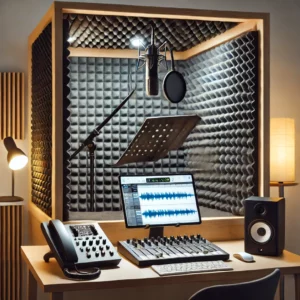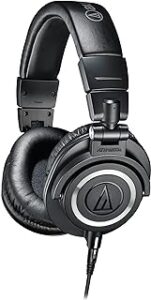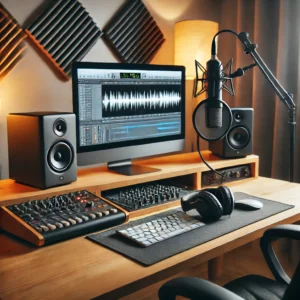The Ultimate Guide to Setting Up Your Home Studio for Audiobook Narration
The demand for audiobooks is at an all-time high, and if you’ve ever dreamed of narrating them from the comfort of your home, now is the perfect time to get started. The good news? Setting up a professional-quality home studio for audiobook narration doesn’t have to be expensive or complicated. With the right equipment, space, and techniques, you can produce studio-grade recordings that meet industry standards.
Whether you’re a beginner or an experienced voice actor looking to upgrade your setup, this step-by-step guide will walk you through everything you need to know to create a high-quality home recording studio for audiobook narration.
Step 1: Choosing the Perfect Room for Your Studio
🔹 Why Room Selection Matters
The room you choose for recording directly affects sound quality. If your space isn’t properly treated, you’ll struggle with echo, background noise, and inconsistent audio levels.
Ideal Room Features:
✔ Small to medium-sized rooms (Avoid large rooms with high ceilings, as they cause more reverb).
✔ Carpeted floors and soft furnishings to absorb sound.
✔ Minimal windows and hard surfaces to prevent echoes.
🔹 Soundproofing: Blocking Out Unwanted Noise
External noise—such as traffic, household sounds, or pets—can ruin your recordings. Soundproofing is essential for professional-quality audio.
✅ DIY Soundproofing Hacks:
✔ Use thick curtains or blankets over windows and doors.
✔ Place foam mattresses or pillows against walls to dampen sound.
✔ Seal gaps in doors with weather stripping to block noise leaks.

✅ Professional Soundproofing Materials:
✔ Mass-Loaded Vinyl (MLV) – Blocks external noise effectively.
✔ Acoustic Panels – Reduces echo and enhances vocal clarity.
✔ Bass Traps – Absorbs low-frequency noise for better sound balance.
📌 Example: John converted his closet into a soundproof recording booth using foam panels and blankets, cutting out 90% of unwanted noise.
🔹 Improving Room Acoustics
Even if you block outside noise, your voice can still bounce off walls and create unwanted reverb.
✅ Acoustic Treatment Tips:
✔ Install foam panels on walls to absorb sound reflections.
✔ Place a rug or carpet on the floor to reduce echoes.
✔ Use bookshelves or furniture to help break up sound waves.
Step 2: Essential Equipment for Quality Audiobook Production
🔹 1. Choosing the Right Microphone
Your microphone is the most important tool in your setup. While dynamic mics are great for live performances, condenser microphones are the best choice for audiobook narration due to their ability to capture vocal nuances.
✅ Best Microphones for Audiobook Narration:
✔ Audio-Technica AT2020 – Affordable and great for beginners.
✔ Rode NT1-A – Low self-noise, perfect for clean narration.
✔ Neumann TLM 103 – High-end microphone with unmatched clarity.
📌 Example: Lisa upgraded from a USB mic to a Rode NT1-A, and her audio quality improved dramatically, leading to more audiobook narration gigs.

🔹 2. Audio Interface: Connecting Your Mic to Your Computer
An audio interface converts your analog voice into digital sound. Choose one with high-quality preamps to ensure clean recordings.
✅ Recommended Audio Interfaces:
✔ Focusrite Scarlett 2i2 – Budget-friendly and easy to use.
✔ Universal Audio Apollo Twin – High-end with professional-grade preamps.
🔹 3. Headphones: Monitoring Your Recordings
Using closed-back headphones is crucial—they prevent sound leakage and help you hear exactly how your recording sounds.
✅ Best Headphones for Narrators:
✔ Audio-Technica ATH-M50X – Excellent sound balance.
✔ Beyerdynamic DT 770 Pro – Comfortable for long recording sessions.

🔹 4. Pop Filter & Shock Mount: Reducing Audio Imperfections
✔ Pop filters reduce harsh “p” and “b” sounds.
✔ Shock mounts prevent vibrations from affecting the microphone.
🔹 5. Digital Audio Workstation (DAW): Recording & Editing Software
A DAW is where you record and edit your audiobook. Choose one that fits your skill level and budget.
✅ Best DAWs for Audiobook Narration:
✔ Audacity (Free) – Simple, beginner-friendly editing software.
✔ Adobe Audition – Advanced features for professional-quality audio.
✔ Reaper – Affordable, powerful, and highly customizable.
📌 Example: Brian started with Audacity but later switched to Reaper, allowing him to fine-tune his audiobook recordings with greater precision.
Step 3: Optimizing Your Recording Workflow
🔹 1. Preparing Your Script for Narration
A well-organized script saves time in post-production.
✅ Best Practices for Reading Scripts:
✔ Use a tablet or e-reader to scroll silently.
✔ Highlight words for emphasis and pacing.
✔ Mark pauses and breathing points to maintain a natural flow.
🔹 2. Setting Up Your DAW for Audiobooks
Audiobook recordings require different settings than music production.
✅ Recommended DAW Settings:
✔ 44.1kHz sample rate for clear sound.
✔ Light compression for even volume levels.
✔ Noise reduction tools to remove background hum.
Step 4: Perfecting Your Audiobook with Post-Production
🔹 1. Editing Your Recordings
Editing transforms raw recordings into high-quality audiobooks.
✅ Essential Editing Steps:
✔ Remove mistakes and long pauses.
✔ Cut out breath sounds and mouth clicks.
✔ Use crossfades to smooth out edits.

🔹 2. Enhancing Audio Quality
Even the best recordings need polishing.
✅ Audio Enhancement Techniques:
✔ Noise Reduction – Removes background noise.
✔ EQ Adjustments – Enhances vocal clarity.
✔ Compression – Balances volume levels for consistency.
Frequently Asked Questions
1. How to Become an Audiobook Narrator from Home?
To start, you need:
✔ A professional home studio setup (as covered in this guide).
✔ Strong voice acting skills and clear diction.
✔ A portfolio with sample recordings.
2. Is Audiobook Narration Profitable?
Yes! Many narrators earn $100 to $300 per finished hour, with top professionals making even more. Platforms like ACX, Findaway Voices, and Voices.com provide opportunities for beginners.
3. What Equipment Do I Need?
At a minimum:
✔ Condenser microphone
✔ Audio interface
✔ Closed-back headphones
✔ DAW for editing
✔ Quiet, acoustically treated space
4. How Many Words is a 1-Hour Audiobook?
A 1-hour audiobook typically contains 9,300 – 9,600 words, depending on narration speed.
Final Thoughts: Bring Your Studio to Life
Setting up a home studio for audiobook narration is an investment in your craft. By choosing the right space, equipping yourself with quality gear, and optimizing your workflow, you can create studio-grade recordings without leaving your home.
💡 Ready to start narrating audiobooks? Drop a comment below and share your setup! 🎙️

Larry Mac
Hi there, and thanks for stopping by! My name is Larry, and I’m the voice behind 6fig.com. I search the Internet to try and find Money making opportunities to share.. Thanks for stopping by, feel free to subscribe and comment. Thank You!
You Got This, I Learned these skills and More at Wealthy Affiliate. Hey if this 65 year old Grandfather can make money online, you can too!
This website got me on the path to making money online! Click Here to Start!


